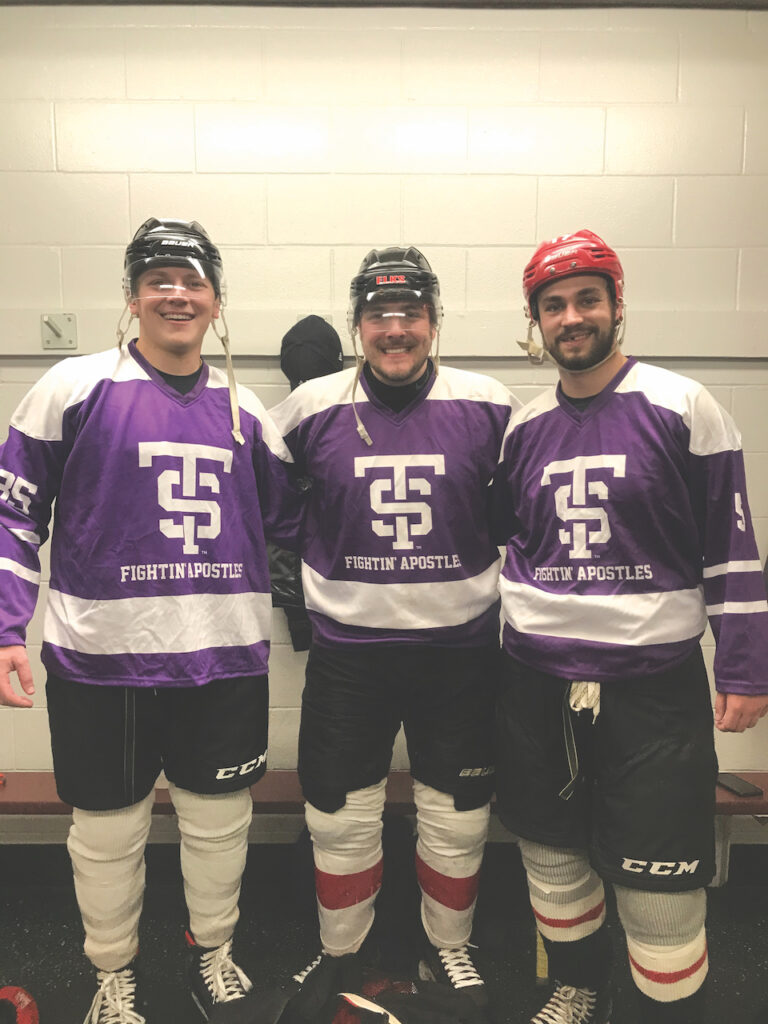Issues of the just and fair treatment of people with developmental disabilities have been on my radar screen all of my life. I have an older brother with developmental disabilities, so I grew up watching my parents’ struggles to secure a decent education and employment for him. Almost 20 years ago, my son was born with developmental disabilities, so I’ve applied the lessons learned from watching my parents to my legal training to do the same for him.
In the 30 or so years between the birth of my brother and the birth of my son, there is no question that the legal protections for and social attitudes toward people with developmental disabilities have improved. I recently read one of the “report cards” sent home to my parents from my brother’s teachers years ago, in which the teacher casually berated my parents for some of my brother’s unusual behavioral tics, explaining that they left him open to ridicule by classmates.
I have never encountered anything similar to that in my dealings with my son’s teachers or classmates. Special education teachers today are typically sensitive to their joint responsibility to work with parents to address behavioral issues that might interfere with social integration. Classmates of my son are so used to integrated classrooms and so effectively schooled in accepting differences while respecting dignity that “making fun of” a classmate with developmental disabilities is, I believe, a rare occurrence.
As an academic, I naturally have felt drawn to exploring disability law scholarship from time to time. Until recently, these projects have been largely theoretical explorations of important (but somewhat abstract) topics, resulting in a law review article on “Hauerwas and Disability Law: Exposing the Cracks in the Foundations of Disability Law” in the Journal of Law and Contemporary Problems (2012) and a book chapter on “Finding Common Ground in the Disability Rights Critiques of Selective Abortions” in In Search of Common Ground on Abortion and Reproductive Justice (Eds. Meredith Esser, Justin Murray and Robin West, Ashgate Press, 2014).
I have written articles in the popular press and given talks on cultural issues raised by my son’s prenatal diagnosis and on spiritual or theological issues raised by the people with developmental disabilities who live among us; however, these reflections have not drawn on legal analysis.
Over the past couple of years, I have been involved in a more practical legal project with a local connection. This project has helped me understand that, as far as we have come in the more-just treatment of people with developmental disabilities in our society, there is still work to be done – work that cries out for the skills of those of us lucky enough to be trained as lawyers.
In March 2013, I was asked by U.S. District Court Judge Donovan Frank if I’d be interested in helping Colleen Wieck, the executive director of the Minnesota Governor’s Council on Developmental Disabilities, with a project involving the establishment of a Disability Justice Resource Center website for lawyers and law students working on disability rights issues.
As I gradually came to understand, this project was one of a series of initiatives resulting from a recent lawsuit in federal court in Minnesota involving a basic issue of disability justice – the right to humane treatment. The case began in 2009 when the parents of three men who had been in the former Minnesota Extended Treatment Options (METO) program in Cambridge, Minnesota, sued the Minnesota Department of Human Services, claiming that “as a means of behavior modification, coercion, discipline, convenience and retaliation, METO staff restrained plaintiffs using law enforcement-type metal handcuffs and leg hobbles for conduct as benign as spitting, laughing or hand washing.”
In December 2011, Judge Frank approved a settlement agreement that awarded the plaintiffs $2.9 million, shut down the treatment program and required the state to:
“immediately and permanently discontinue the use of mechanical restraint (including metal law enforcement-type handcuffs and leg hobbles, cable tie cuffs, PlasticCuffs, FlexiCuffs, soft cuffs, posey cuffs and any other mechanical means to restrain), manual restraint, prone restraint, chemical restraint, seclusion, and the use of painful techniques to induce changes in behavior through punishment of residents with developmental disabilities. Medical restraint and psychotropic and/or neuroleptic medications shall not be administered to residents for punishment, in lieu of adequate and appropriate habilitation, skills training and behavior supports plans, for the convenience of staff and/or as a form of behavior modification.”
Approximately $130,000 remained in settlement funds after certain class-action members declined payment, asking instead that the court “do something good with the money.” In response to that request, Frank ordered a cy pres fund be established for a public education campaign to break stereotypes about people with developmental disabilities.
The project I was asked to help with was only one aspect of that public education campaign. In addition to working with the local Bar to create CLE programs on disability law topics, Frank and Wieck engaged the support of Twin Cities Public Television (TPT) in two major projects: the production of an original TPT documentary “Independence to Inclusion” and the creation of the Disability Justice website: disabilityjustice.tpt.org.
The website is intended as a resource for “legal professionals, continuing legal education courses, law schools, students and others dedicated to protecting the rights of people with developmental disabilities.” The website taps into the resources already collected on the robust website of the Minnesota Governor’s Council on Developmental Disabilities, which details the history and current state of the disability rights movement, as well as the wealth of free online legal resources available for lawyers. It situates these resources into the context of the evolution and current state of disability rights laws.
The website is further enriched by video clips produced by TPT, in which a self-advocate and a faculty of 11 judges, professors and practicing attorneys in disability rights advocacy add depth to the narrative presented on the website. Additional historical sources of interest to lawyers and disability activists include 30 historical videos featuring important judges and lawyers in the fight for disability rights, such as U.S. Supreme Court Justice Harry Blackmun, U.S. District Judge Raymond Broderick and U.S. District Judge Frank Johnson, as well as photos from famous lawsuits such as those involving the eventual closure of East Coast institutions such as Welsch and Willowbrook state hospitals and Pennhurst State School.
I was asked to help identify experts for the video “faculty” and to help the governor’s council with the legal discussion on the website. I was lucky to have the resources of the University of St. Thomas School of Law community for both of these tasks. Among the experts I quickly identified was my colleague, professor Jennifer Wright. Her clear and trenchant explanations of the legal issues involved in representing people with developmental disabilities in guardianship proceedings make an invaluable contribution to the website. Another expert is Minnesota Supreme Court Justice Wilhelmina M. Wright, a longtime adjunct professor at UST School of Law. Her explanations of the accommodations available in Minnesota courts to facilitate access to people with disabilities are informative and inspiring.
I was asked to address the issue of voting rights for people with developmental disabilities, which is more complex than it might appear at first glance, both across the country and in Minnesota.
Another source in the UST School of Law community that proved invaluable in my work was the expertise and dedication of two law students I was fortunate to convince to work with me as research assistants. Julie Cayemberg ’14 was tenacious in her dedication to identify free online sources for virtually all of the important legal documents identified in the narrative. Over the course of a year, she also researched countless issues of disability rights, particularly those relating to the Americans with Disabilities Act. Rachel Arneson ’15 was invaluable in applying her technical skills and analytical abilities to help finalize the presentation of the material into a coherent and usable final product, and she continues to help keep the site updated.
Working on this project was an inspiration to me in a number of ways. First, it introduced me to an inspiring group of dedicated lawyers and activists in the disability rights community.
Second, it taught me extremely valuable lessons about the need for continued legal activism in this area. On the one hand, the “Basic Legal Rights” section of the website offers an inspiring perspective on the evolution of our fundamental civil rights laws to recognize the right of people with developmental disabilities to live with dignity in our communities rather than in segregated institutions, to be free from unnecessary restraints, to be educated in our public schools, to work, and not to be subject to involuntary sterilization or servitude. On the other hand, over the two years spent working on this project, I received constant reminders of how much work remains to be done.
The website is peppered with links to recent news reports of the continued disregard for the dignity and legal rights of people with disabilities. The story of a group of men with cognitive disabilities locked up at night in a vermin-infested building, released in the day to eviscerate turkeys for $65 a month, reads like something from a Victorian horror novel rather than a New York Times report about a situation uncovered in 2009 in rural Iowa. Equally heartbreaking are some of the other stories outlining the continued abuse and exploitation of people with cognitive disabilities, found in the website pages dedicated to “Justice Denied.”
Even with respect to the source of funding for the website itself – the legal settlement with the state of Minnesota reached in 2011 – there are constant reminders of the work remaining. Judge Frank has had to appoint a court monitor, disability rights lawyer David Ferleger, to oversee implementation of the settlement agreement and has twice extended the court’s jurisdiction over the case in the face of the state’s continued failure to live up to its agreement.
In a September order extending jurisdiction for another two years, Frank wrote: “Multiple admonitions to the Department of Human Services have been insufficient to secure effective action by the DHS to close the significant gaps between its stated intentions and actions. Continued implementation delays can no longer be tolerated. More importantly, the dignity, quality of life and best interests of every class-action member and similarly situated individuals with disabilities hinge on fulfillment of the promises made by defendants at the fairness hearing in this matter.”
On Oct. 17, 2014, the court monitor submitted another report titled “Behavioral Intervention Devices and Practices: Achieving Compliance in Community Programs,” documenting continued use of restraints in violation of the settlement agreement with respect to two people: a man in a state-run home who essentially was isolated in his room 90 percent of the day, leaving his residence only a handful of times a year, and a woman in a state-licensed group home who repeatedly was confined to a restraint chair for up to nine hours a day without food or bathroom breaks. (The latter violation also was documented in an investigation by the Minnesota Department of Human Services, which resulted in a $2,000 fine being assessed on the group home.) Ferleger also offered data that “verified extensive statewide use in the community of mechanical and other restraints, including life-threatening prone restraint.”
As discouraging as this evidence of continued dehumanized treatment of people with developmental disabilities can be, I also know many dedicated legal professionals are engaged in the battle to prevent this kind of behavior, and at least one more resource exists to support this work.
Elizabeth Schiltz is a UST School of Law professor, Thomas J. Abood Research Scholar, and co-director of the Terrence J. Murphy Institute for Catholic Thought, Law and Public Policy.
Read more from St. Thomas Lawyer.







